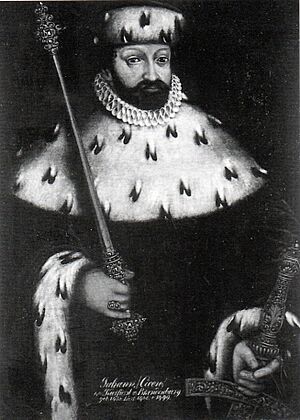John Cicero, Elector of Brandenburg facts for kids
Quick facts for kids John Cicero |
|
|---|---|
 |
|
| Elector of Brandenburg | |
| Reign | 11 March 1486 – 9 January 1499 |
| Predecessor | Albert III Achilles |
| Successor | Joachim I Nestor |
| Born | 2 August 1455 Ansbach |
| Died | 9 January 1499 (aged 43) Arneburg Castle |
| Spouse |
Margaret of Thuringia
(m. 1476) |
| Issue |
|
| House | Hohenzollern |
| Father | Albert III Achilles, Elector of Brandenburg |
| Mother | Margaret of Baden |
John II (born August 2, 1455 – died January 9, 1499) was an important ruler known as the Elector of Brandenburg. He was part of the famous House of Hohenzollern family. John ruled from 1486 until he passed away in 1499. After his death, people started calling him "Cicero." This nickname came from a famous speaker in ancient Rome. However, it's not clear if John was really as good at speaking or as interested in art as the Roman Cicero.
Contents
Early Life and Family
John Cicero was the oldest son of Elector Albert III Achilles and his first wife, Margaret of Baden. He was born in Ansbach, a town in a region called Franconia. This was where his father ruled as a "Margrave," which was like a powerful count.
Becoming an Heir
In 1466, when John was about 11 years old, his uncle, Elector Frederick II, called him to Brandenburg. John was expected to become the next ruler there. He even joined his uncle in a war against the dukes of Pomerania.
Taking on Responsibilities
In 1470, his uncle Frederick II stepped down. John's father, Albert III Achilles, became the new Elector. In 1473, John's father made him the "regent" of Brandenburg. This meant John was in charge of managing the lands. He had to deal with some conflicts, including a dispute over who would inherit land after a duke named Henry XI of Głogów died.
Marriage and Children
On August 25, 1476, John married Margaret of Wettin in Berlin. Margaret was the daughter of Landgrave William III of Thuringia.
John and Margaret's Children
John and Margaret had several children:
- Wolfgang (born and died in 1482)
- Joachim I Nestor, Elector of Brandenburg (born February 21, 1484 – died July 11, 1535). He later became the Elector of Brandenburg.
- Elisabeth (born and died in 1486)
- Anna of Brandenburg (born August 27, 1487 – died May 3, 1514). She married King Frederick I of Denmark.
- Ursula of Brandenburg (born October 17, 1488 – died September 18, 1510). She married Duke Henry V, Duke of Mecklenburg.
- Albert of Mainz (born 1490 – died September 24, 1545). He became a Cardinal and an Archbishop.
Rule as Elector
In 1486, John became the Elector of Brandenburg after his father passed away. His younger brothers, Frederick I and Siegmund, took over the family's lands in Franconia.
Making Berlin the Capital
John Cicero made an important decision for Brandenburg. He declared that the Stadtschloss (City Palace) in Berlin would be the permanent home for the Electors. This was the beginning of Berlin becoming the official capital city.
New Taxes and Challenges
In 1488, John introduced a new tax on beer. This tax caused some problems and protests, especially in the towns of the Altmark region.
Expanding Brandenburg
In 1490, John was able to buy the territory around Zossen, which was part of Lower Lusatia. The king of Bohemia, Vladislaus II, agreed to this purchase. John also continued to claim the lands of Pomerania for his family.
Death and Legacy
John Cicero passed away in 1499 at Arneburg Castle. He died from a lung condition called pleural effusion. His oldest son, Joachim I, became the next Elector.
John was the first Elector from the Hohenzollern family to be buried in Brandenburg. He was first buried at Lehnin Abbey. Later, his grandson, Joachim II, ordered his remains to be moved to Berlin Cathedral.

